You are invited to become not just a subscriber to Chartbook Newsletter, but a supporter of the project.
Chartbook Newsletter is a blast to write. But it is also very time-consuming. To see where it should fit in my portfolio of other activities, I am launching a paid subscription model.
Don’t panic. If you like the newsletter but can’t afford a paid subscription, I get it. You don’t have to do anything. You will continue to receive Chartbook, as before. But, if you can afford it, if you think the content is valuable, if you would like to support the mission, or simply buy me the equivalent of a cup of coffee once a month, there are three options:
- The annual subscription: $50
- The standard monthly subscription: $5 monthly – which gives you a bit more flexibility.
- Founders club: If you really love Chartbook Newsletter, or read it in a professional setting in which you regularly pay for subscriptions, please consider signing up for the Founders Club with a recommended contribution of $120 annually, or another amount at your discretion. Good karma guaranteed.
To support the project please click here:
What are you contributing to? The continuation of Chartbook Newsletter as you already know it. A bunch of great content c. 40 post per annum. A list of forthcoming projects and a full-length appeal can be found in the last mailing.
A HUGE thank you to everyone who has already hit the subscribe button. Your support is a great encouragement.
******************************************
Last week the US government took the decision to extended temporary protected status to c. 150,000 people of Haitian citizenship living in the US. This status, first granted by Obama in 2010, had been put in question by the Trump administration. Deportations had gathered pace at the beginning of 2021. In recognition of the situation of crisis in Haiti, they have now been, once again, halted
Haiti’s conditions are extreme, but large parts of the Caribbean and Central America region are currently under huge stress. This flickers on the US radar in the form of the refugee crisis on the US-Mexican border. The most desperate migrants come not from Mexico, but from the Northern Triangle of Central America. UNCTAD warns of the risk of debt crises afflicting small island developing states in the Caribbean. Even in the Caribbean territories of France and the Netherlands, tensions are rising.
COVID has compounded preexisting problems of insecurity, climate risk and failed development. There are few places in the world where the blowback from global environmental change is felt in more concentrated form than in Central America and the Caribbean. Economies that are heavily dependent on tourism, with limited domestic healthcare facilities, are exceptionally vulnerable to a global pandemic. With no option but to lockdown, in 2020 the Bahamas suffered a 17 percent fall in GDP.
When COVID struck, the region was recovering from a devastating sequence of hurricanes: Maria in 2017, Dorian in 2019 and Eta in 2020. Bananas, an important cash crop for Costa Rica and Guatemala, are threatened by Panama disease which was first identified in the monocultural plantations of central America in the 1940s. Peasant farmers are struggling to cope with a protracted drought. To add to the pressures of the anthropocene, the region is also subject to natural shocks of a deeper temporality. The region is defined by the butting together of the North and South American tectonic plates. Volcanic eruptions (Monserrat 1995, St Vicent 2021) and earthquakes (Haiti 2010) regularly deliver havoc.
In large and wealthy countries with strong safety nets, localized natural disasters can be absorbed. For the smaller states of Central America and Caribbean such shocks can easily become all-consuming. As the IMF summarizes: “Since 1950, 511 disasters worldwide have hit small states … Of these, 324 were in the Caribbean, home to a predominant share of small states … Average estimated disaster damage as a ratio to GDP was 4.5 times greater for small states than for larger ones, but six times higher for countries in the Caribbean. Moreover, the region is seven times more likely to be hit by natural disasters than larger states and twice as likely as other small states. For some countries, the damage well exceeds the size of the economy: Hurricane Maria is estimated to have cost Dominica 225 percent of its GDP, while the hurricane damage for Grenada in 2004 was 200 percent of GDP”.
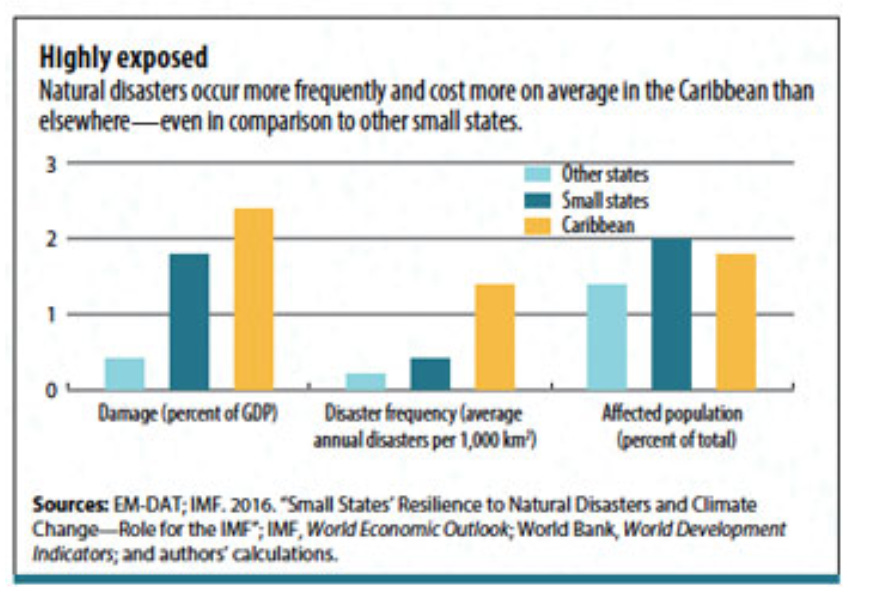
The damage to the larger nations of the region is proportionally less severe. But none of them is large or rich enough to recover easily. Haiti still bears the scars of the earthquake of 2010 and the botched relief effort that followed. Approaching the two year anniversary of hurricane Dorian, in the Abaco Islands of the Bahamas billionaire luxury coexists with bare life amongst the ruins.
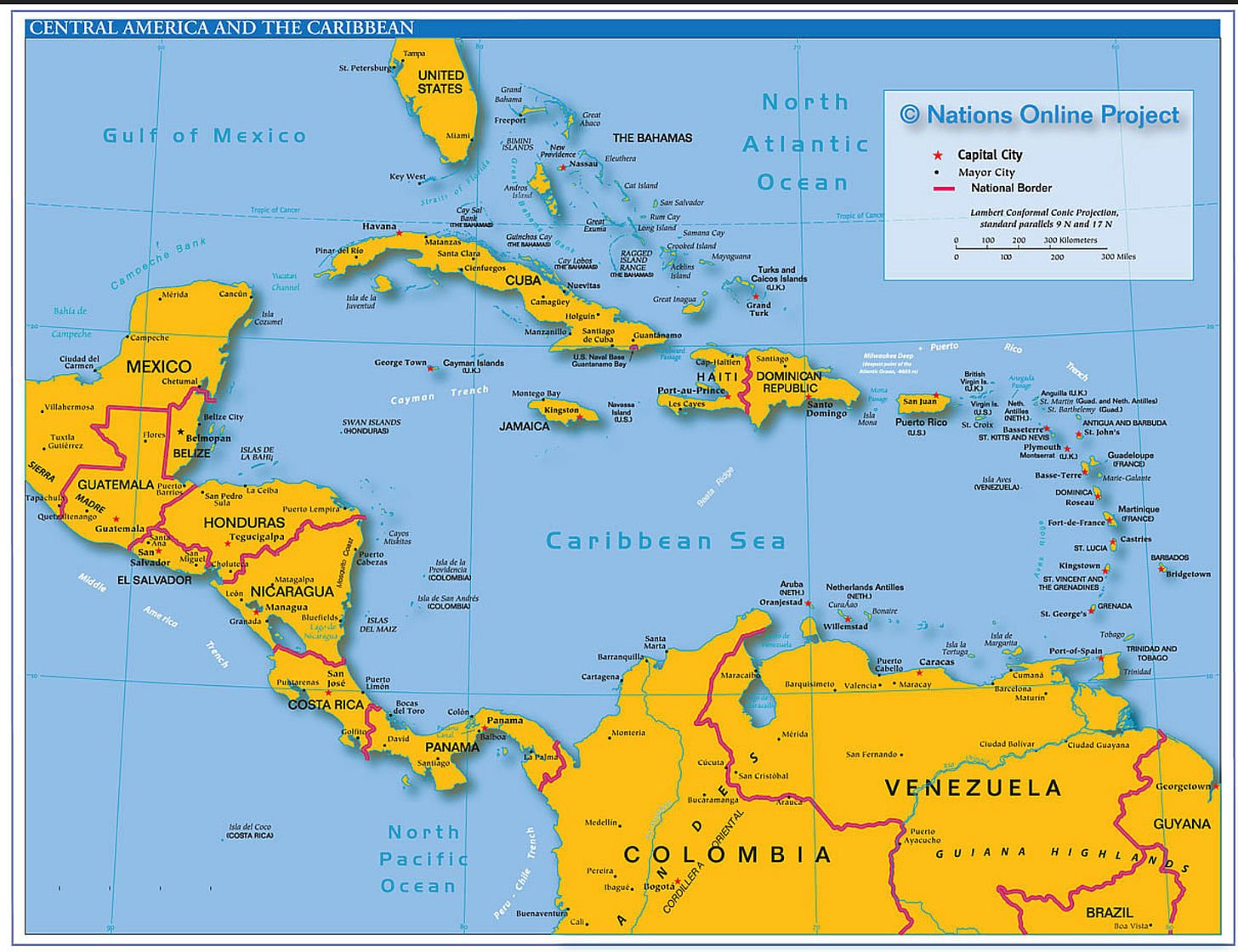
Source: https://www.nationsonline.org/oneworld/map/central_america_map2.htm
The region might be better able to cope, if shocks could be absorbed through common resources, or pools of credit. If you lump all the islands of the Caribbean and the Central American zone from Panama to Belize together, you have a substantial bloc with a combined GDP of over $400 billion and a population of 90 million. But this unit exists only in the mind of management consultants and statisticians. In actual fact, 90 million people are spread across a fragmented collection of 35 nations and territories.

The region is a shatter zone of empire, settler colonialism, mono-cropping plantation agriculture, resource extraction and former slave-based economics, imperialism and national liberation struggles. It is an arena of combined and uneven development in extreme form. Burned-out experiments in economic nationalism, socialism on one island and colonial hangovers, oligarchic tax havens, petrochemical complexes, gated tourist resorts, maquiladora manufacturing zones, peasant agriculture exist side by side. Integrated into a single unit, they might form a diversified regional economy. Instead, they are thrown together in a Balkanized patchwork. The region, one is tempted to say, consists of a collection of overlapping “peripheries”.
Earlier this week, American Affairs published a brilliant essay by Alex Hochuli proposing that readers in the West should recognize the “Brazilianization” of “the world”. The essay should be widely read. It paints a compelling picture of a world discovering that it is “modern but not modern enough”.
In translating Hochuli’s tour de force into figures for GDP per capita, one risks banality. But it is worth pointing out that for much of the period after 1950, Brazil’s GDP per capita, in fact, did closely track that for the world as a whole.
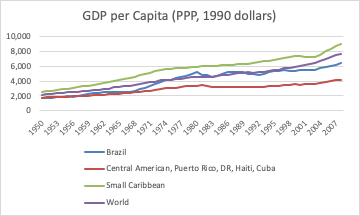
Source: OECD, Angus Maddison
It is also striking, however, that since the late 1990s as the global growth rate was lifted by the dramatic acceleration of Asia, Brazil has found itself falling behind. Brazil’s recession that began in 2014 was exceptionally severe. For all its historical depth, one can’t help wondering how far the sense of resignation that pervades Hochuli’s essay, in fact, reflects the setbacks that Brazil has suffered in recent years.
“Welcome to Brazil. Here the only people satisfied with their situation are financial elites and venal politicians. Everyone complains, but everyone shrugs their shoulders. This slow degradation of society is not so much a runaway train, but more of a jittery rollercoaster, occasionally holding out promise of ascent, yet never breaking free from the tracks. We always come back to where we started, shaken and disoriented, haunted by what might have been. … Brazil consequently finds itself stuck—caught in the perennial fluctuation between hope and frustration. And the fate of being modern but not modern enough now seems to be shared by large parts of the world:” Source: American Affairs
Since 1987 the overall growth record of Latin America and the Caribbean has, indeed, been disappointing. On average it has been worse than that of sub-Saharan Africa. Given their low starting point, African countries still lags far behind. But Latin America has been comprehensively outgrown by South Asia and East Asia.

Source: McKinsey
Indeed, with the Caribbean and Central American in mind, one can’t help wondering whether Brazilianization is not, in fact, overoptimistic. In terms of GDP per capita, the larger states Caribbean and Latin American states have dragged even further behind. And with relative poverty comes powerlessness. Brazil, may disappoint, but it remains a giant nation state, dwarfing all its neighbors. Since the end of the Cold War, it has claimed leadership as a founding member of the BRICS. This might be dismissed as the vanity of elites, but under the PT, Brazil’s government machinery, creaky though it may be, demonstrated considerable capacity for redistribution. Inequality declined. Environmental degradation in the Amazon slowed sharply. In the great contemporary dramas of the anthropocene and the rise of China, Brazil is an actor as much as it is acted upon. Or at least it could be.
It is precisely Brazil’s scale that gives Hochuli’s conceit its plausibility. But that in itself marks Brazil’s experience as distinctive. Brazil’s narrative as he portrays it, is one of a giant country, a country that might be a historical agent in the full sense of the word, failing to live up to its promise. That is not the situation of Haiti, of Nicaragua or Guatemala. Nor is it the fate of much of the rest of Latin America or sub-Saharan Africa, or Oceania. Directed against the solipsistic Angst of the US or the Eurozone, the Brazilianization thesis is telling. But, the mirroring back and forth between the more or less successful “great powers”, fascinating though it may be, should not be mistaken for “the world”.
Inequality in Brazil is notorious. But it is inscribed within the boundaries of a national unit. Indeed, in the current moment, it is strikingly domestic and non-globalized. That was not always the case. Nineteenth-century Brazil was the great hub of the Atlantic slave economy and a magnet for European migrants. Today foreign-born people make up less than 1 percent of Brazil’s population. At 25 percent of GDP, Brazil’s exposure to world trade is one of the lowest in the G20. Brazil’s elite wall themselves off and create enclaves, but they form states within a state only in a metaphorical sense. In a fractured region like the Caribbean and Central American region, the borders are real borders. National separation directly reinforces social and racial hierarchy.

At one end of the spectrum are the Bahamas, at the other, Haiti. Whereas Barbados, Costa Rica and Panama have GDP per capita on a level with Chile, the most affluent of the South American economies, Guatemala, El Salvador and Honduras bring up the rear.
The Dominican Republic’s average GDP per capita puts it roughly on a par with Brazil. Forty percent of the population has achieved “middle-class” status. In terms of chronic youth unemployment, informality of labour markets and persistent poverty, the DR looks like a mini-Brazil. But, even in its most deranged moments, Trujillo never held out a Brazilian-style future for his small future. What he did confront, with extreme violence was the stark reality that the Dominican Republic shares the island of Hispaniola with Haiti. So stark is the difference between the two countries today, that the state border can be seen from space. It is inscribed into the landscape.

On the right hand side, the lush green of the Dominican Republic. On the left the deforested landscape of Haiti. Unable to afford fossil fuels, the Haitian population burns charcoal. Deforestation and erosion have stripped much of Haitian end of the island down to the bare rock.
From Haiti overcrowded sailing sloops carry workers around the Caribbean and beyond. According to the World Bank, remittances from the 1.6 million Haitians living outside the country added up to nearly $3.3 billion in 2019 and accounted for 37 percent of the country’s gross domestic product (GDP)—a share larger than every country in the world except Tonga.
Roughly 800,000 people of Haitian ancestry live in the Dominican republic, where their status has recently come under assault due to retrospective changes to the DR’s citizenship laws that threaten the basic rights. In the Bahamas with a total population of 389,000, perhaps one in seven people are from Haiti or of Haitian extraction. When hurricane Dorian devastated the Abacos and Grand Bahamas in September 2019, Haitian shantytowns bore the brunt of the destruction. The number of dead in “Pigeon Peas” and “the Mud” in Marsh Harbor will never be counted.
Caribbean island centers of tourism and offshore finance often register high per capita GDP levels. But that is not the same as a viable, long-run growth model. Once translated into PPP constant dollars, the economy of the Bahamas has fluctuated around its current level of c. 35,000 PPP dollars for thirty years.
Only three countries in the region – Costa Rica, the Dominican Republic, and Panama – with just over 20 percent of the region’s population between them, have been able to sustain rapid growth over a thirty year period. Each occupies a clear niche.
Costa Rica has a highly educated population. It is the main destination for foreign direct investment in business-support services in Latin America. It has a fast-growing medical-device-manufacturing sector that generated $4 billion in exports in 2018. Costa Rica has a booming eco tourism business. The Dominican Republic which was once primarily a low-coast manufacturing center, now boasts the second-largest tourist economy in Latin America. It draws in FDI on a large scale and has set itself the objective of achieving high-income status by 2030. Panama’s economy centers on the canal and the financial center clustered around it. The logistics industry in Panama accounts for 19 percent of the world total in dead-weight tonnage.
There are other nodes of growth. Honduras, has become a major garment production center, being the leading exporter of T-shirts to the United States. Honduras and Nicaragua have developed a specialization in the export of wiring-harnesses for global auto manufacturers including Ford, General Motors, Chrysler, Kia, Hyundai, Subaru, BMW and Audi. Major suppliers to the industry such as Japan’s Yazaki, German-based Draexlmaier and French automotive manufacturer, Delfingen, have all opened plants. Central America is also involved in the auto supply chain as a supplier of exhaust systems for companies such as BMW, Volkswagen and Harley Davidson.
But these patterns of growth are fragile and utterly dependent on external demand and foreign finance. Following the COVID shock, UNCTAD has sounded the alarm bell about the sustainability of debt amongst many small-island borrowers.

Source: https://unctad.org/news/small-island-developing-states-need-urgent-support-avoid-debt-defaults
Brazil was not immune to the storms in global financial markets in 2020. But its foreign exchange reserve of over 350 billion dollars gives it a real measure of autonomy. For all the pressure on the real, Brazil was free to mount a large fiscal response to the crisis. And Brazil’s elite can count on powerful support from the outside. In 2020, as in 2008, Brazil was provided with a dollar swap line from the Fed. Amongst “emerging markets”, only South Korea, and Mexico were in the same position. Indonesia was rebuffed.
Apart from dollar support, a major source of domestic resilience for Brazilian finances is the fact that domestic capital markets are deep. Most of Brazil’s public debt is owed to domestic creditors. The share of domestically held debt for the Central American countries was half that of Brazil. In the crisis they were forced to turn to the IMF and the World Bank.
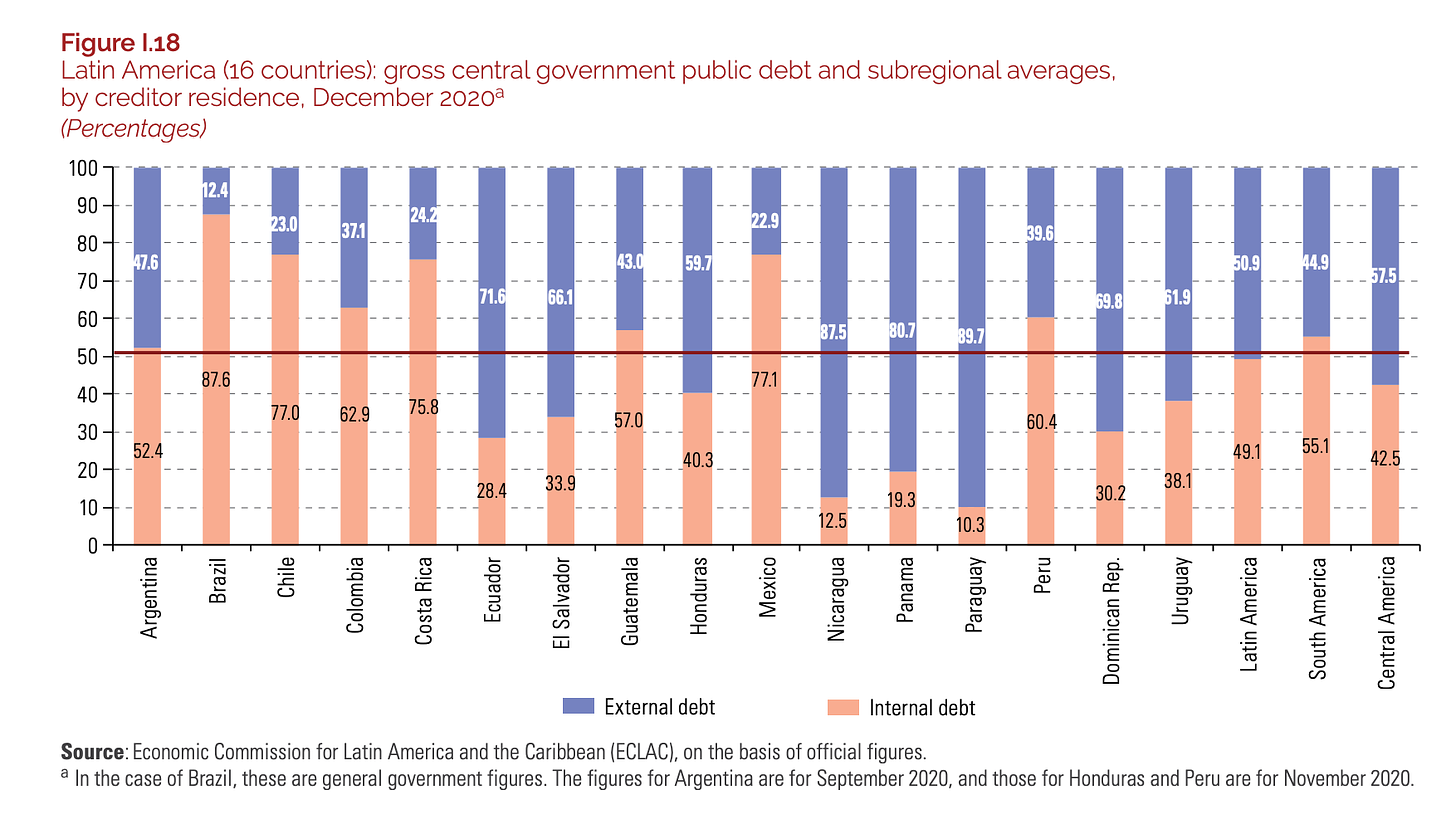
Source: CEPAL
The core of Hochuli’s argument is about temporality, about history, about past-present and future, about the way in which Brazil scrambles categories of modernity and modernization. In economic sense this is about knowledge and technology. In an aside, Hochuli gestures to the hierarchy of global intellectual property, in which Brazil occupies an inferior position. This is no doubt true, when compared to Germany or Japan, for instance. But how inferior? Is Brazil really like “the world”?
According to OECD data, Brazil spends 1.2 percent of GDP on R&D. That is less than the 2.1 percent spent by the EU. But the most recent figure reported for the Dominican Republic, the success story of the Caribbean, is 0.01%. In 2018 240 scientific papers in leading global journals were published for every million of the Brazilian population. That put it on a par with Russia. For the Dominican Republic the number is 4. In 2018 3.45 patents were filed for every million population of Brazil, twice the world median and ten times the number filed by residents of the Dominican Republic.
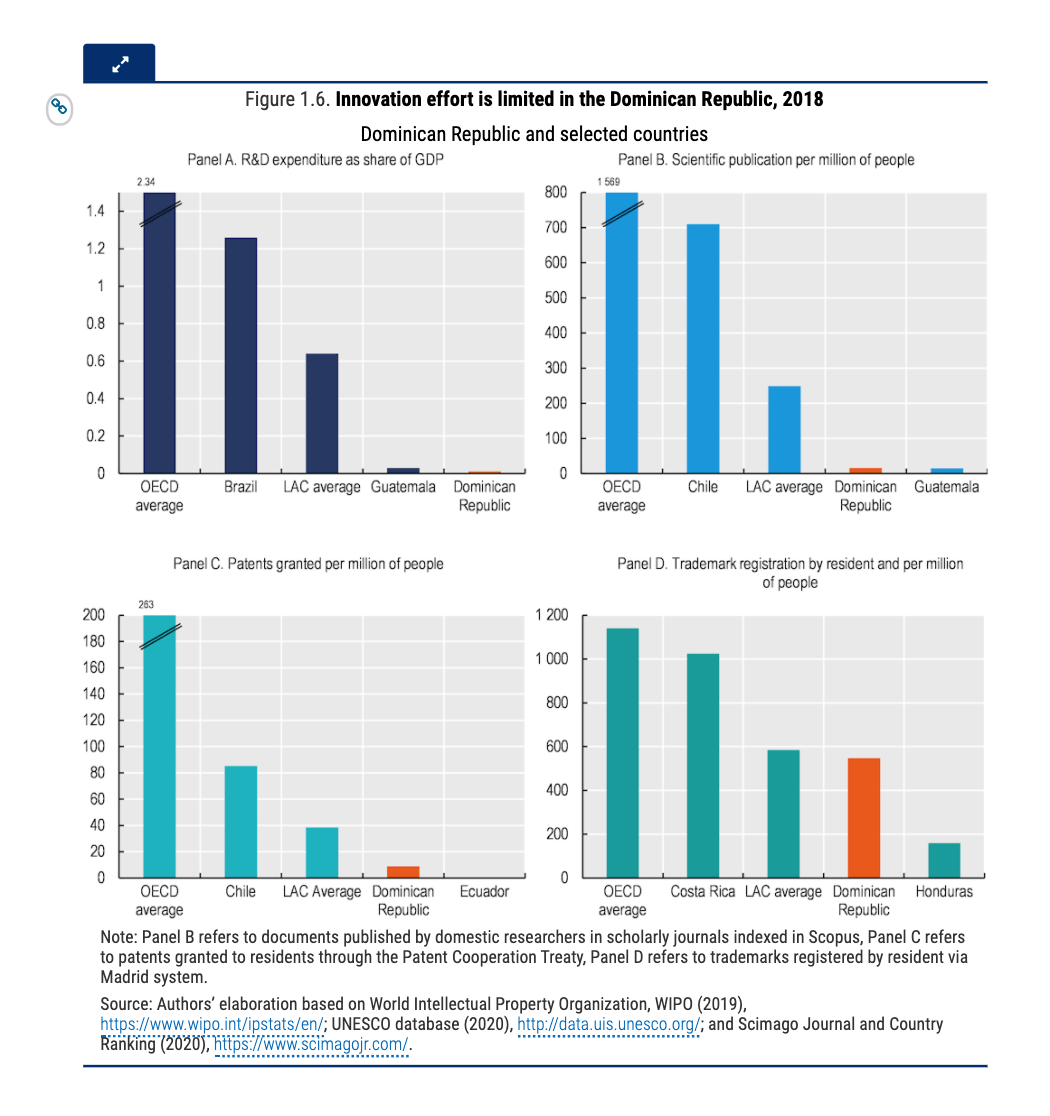
Evoking the prospect of Brazilianization may cause a frisson in Miami or Rome. But for large parts of the world it is wishful thinking. The point is not to suggest that what awaits “the world” is actually Caribbeanization. The point is to recognize the limits of any such synecdoche – a part standing for the whole. The world as it shaped by the dynamic of uneven and combined development will always make it tempting to reach for such totalizations. Hochuli’s essay brilliantly conveys the general struggle to grasp what is happening to us. And globalization, by creating comparabilities, makes connections and similarities visible. Modernization theory, with all its blindspots, is a hard habit to break. But, if our aim is not to use “the world” as a foil onto which to project national dramas, but to actually think about it, we will be better served not by defining norms, whether they be Western Europe, the US or Brazil, whilst relegating China, for instance, to the category of exceptional Sonderweg. It is the process of uneven and combined development itself, the generator of similarity and difference that we should be focusing on.
